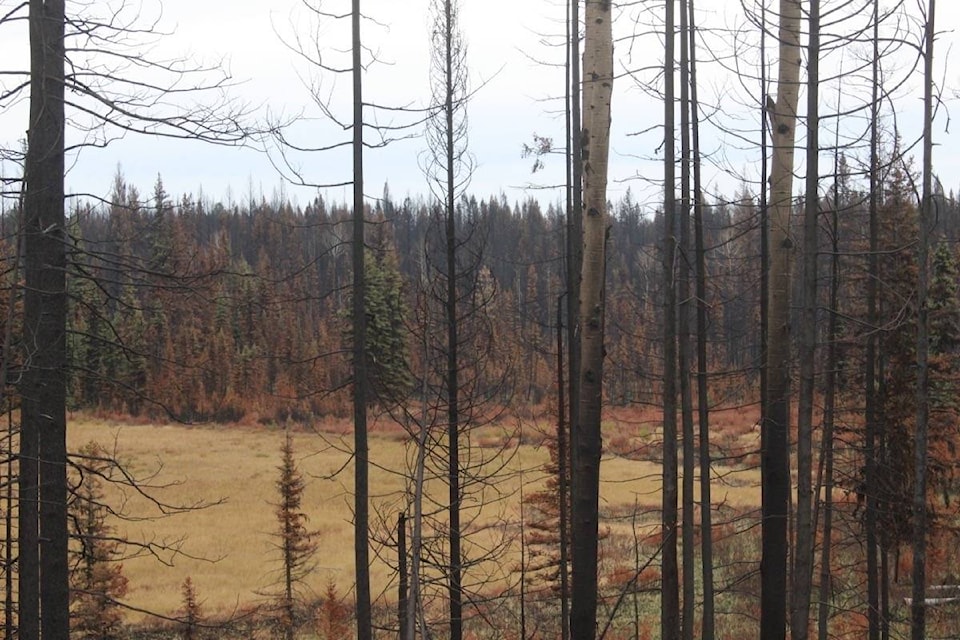The Cariboo Regional District (CRD) and the City of Williams Lake introduced Resolution LR2 at the recent UBCM Convention that called for changes to the Forest & Range Practices Act, to include regulations that initiate a Fire Mitigation Strategy.
It would prioritize public safety over other forest management initiatives, including harvesting and reforestation of the affected areas.
The resolution preamble noted wildfires have plagued much of British Columbia’s Interior — including the Quesnel area — this summer, and will continue to threaten communities, particularly with predicted climate change.
It also pointed out current forest restrictions continue to hamper fire mitigation efforts, and public safety should be the number 1 priority.
Noting he spoke to the resolution from the UBCM floor, CRD chair Al Richmond says there has to be change to how the forests are managed.
“Given what happened this past summer, in part it was due to current forest management practices that have culminated over the last 20 years.
“We need to look at those practices because of the fuel that’s on the floor of the forest and items like that.”
In the past, before they re-planted an area that had been logged, they would broadcast burn it and then they would plant it, Richmond says.
What happens now, he adds, is they don’t broadcast burn before they plant the trees.
“What seems to be evident in some of the fires this year is the areas that had been broadcast burned and then planted, the fuel on the ground wasn’t there, so the fires couldn’t get a hold.”
Those blocks have been saved for the most part, he says.
“Whereas the stands where the new practice is in place and the fuel is left on the forest floor, have taken them out by the fires.”
The CRD chair says trees that were past having to be nurtured and growing on their own that would have been ready for the Allowable Annual Cut have been lost.
“Whereas, the ones that have been managed differently seemed to have survived. We haven’t lost that potential cut in the future because those trees haven’t been damaged.”
He adds the people who know quite a bit about forestry are suggesting we have to go back to the practices that were “tried and true.”
“They’re looking at whether the current practices valid or whether they should look at the previous practices.
“I think there are some new practices are really good – we utilize more of what’s on the forest floor than we used to – and that is good.
“But this business of not broadcast burning because of concerns about prescribed burns and all of the smoke [is wrong]. We just went through three months of smoke instead of one month of smoke if we were burning in April or May.
Richmond adds prescribed burns are more controlled than the recent massive fires for a number of reasons.
“The mountain pine beetle was part of it; the climate change was part of it; the drought was part of it; and the practices were part of it.
“We can’t do a lot about drought … we can probably do something about how we manage the forest floors to ensure fuel isn’t there to burn.
“We have all this stuff standing up from the mountain pine beetle that we’ve never gone and got. If you drive into Barkerville, you’ll see this grey stuff standing there.
“We have to do something with that because if we don’t, mother nature will do what she did this year. But next time, it will be the historical town of Barkerville, which only has one way out it largely, and Wells will be in jeopardy.
“We need to be more proactive and get rid of this dead and down rather than be reactive and having these huge fires.”
He notes more than half a billion dollars have been spent on fires in the province, but there is dry material in the forest that has to be taken out.
“There needs to be some [financial] encouragement to get it cleaned up and taken out somehow, or at least we need to not repeat those practices.
“We may not be able to go back, but what we want to be sure of is we’re not continuing to repeat practices that appear to be not in the best interest of the province and not in the best interest of the forest.”
Richmond isn’t sure what can be done with the dead and down now, but suggests it might be OK for wood pellets or as fuel for co-generation plants. He notes it would depend on the usability of the fibre.
He adds the mindset might not be we’re taking it to produce lumber, but rather we’re taking it for forest health and public safety.
The resolution passed.
